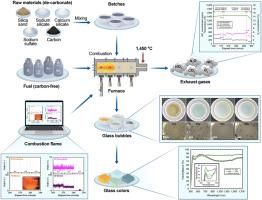Impact of NH3 combustion on the properties of carbonate-free Na/Ca silicate-based soda-lime silicate glass
IF 7.9
3区 材料科学
Q1 GREEN & SUSTAINABLE SCIENCE & TECHNOLOGY
引用次数: 0
Abstract
The traditional soda-lime silicate glass (SLS glass) melting process, utilizing fossil fuels and carbonate-containing raw materials, generates significant CO2 emissions. Alternatively, NH3 is gaining attention as a carbon-free fuel. Additionally, Na and Ca silicates possess the appropriate composition for SLS glass formation and do not emit CO2 during melting. However, limited studies have reported SLS glass melting with NH3 combustion owing to the difficulty faced during NH3 combustion at high temperatures as 1450 °C. In this study, we used a model furnace with experimental glass melting conditions set at 1450 °C or higher, employing two-stage combustion on parallel independent jets to conduct melting experiments, where carbonate-free SLS glass raw materials are vitrified through NH3 combustion. The resulting glass is subjected to material analysis using XRD, XRF, and gas chromatography to assess the occurrence of bubbles, inclusions, and color tone according to industry quality standards. The results demonstrate the feasibility of melting decarbonized SLS glass using NH3 combustion and carbonate-free materials. However, NH3 combustion influences the color tone, glass transition temperature, and clarity. Developing cost-effective methods for producing silicates without CO2 emissions is crucial for alternative raw materials to remain competitive with conventional options. This method of preventing CO2 generation from both raw materials and fuel in glass production indicates that combining decarbonized fuel combustion and silicate-based glass melting holds promise for reducing CO2 emissions.

NH3燃烧对无碳酸盐钠/钙硅酸盐基钠石灰硅酸盐玻璃性能的影响
传统的钠钙硅酸盐玻璃(SLS玻璃)熔融工艺使用化石燃料和含碳酸盐的原料,产生大量的二氧化碳排放。另外,NH3作为一种无碳燃料正受到关注。此外,Na和Ca硅酸盐具有适合SLS玻璃形成的成分,并且在熔化过程中不释放CO2。然而,由于在1450℃的高温下NH3燃烧过程中存在困难,SLS玻璃在NH3燃烧过程中熔化的研究有限。在本研究中,我们使用模型炉,实验玻璃熔融条件设置为1450℃及以上,采用平行独立射流两段燃烧进行熔融实验,无碳酸盐SLS玻璃原料通过NH3燃烧实现玻璃化。根据行业质量标准,使用XRD, XRF和气相色谱法对所得玻璃进行材料分析,以评估气泡,夹杂物和色调的发生情况。结果表明,采用NH3燃烧和无碳酸盐材料熔融脱碳SLS玻璃是可行的。然而,NH3燃烧会影响颜色色调、玻璃化转变温度和透明度。开发成本效益高、不排放二氧化碳的硅酸盐生产方法对于替代原材料保持与传统选择的竞争力至关重要。这种防止玻璃生产中原材料和燃料产生二氧化碳的方法表明,将脱碳燃料燃烧和硅酸盐基玻璃熔化相结合,有望减少二氧化碳排放。
本文章由计算机程序翻译,如有差异,请以英文原文为准。
求助全文
约1分钟内获得全文
求助全文
来源期刊

Materials Today Sustainability
Multiple-
CiteScore
5.80
自引率
6.40%
发文量
174
审稿时长
32 days
期刊介绍:
Materials Today Sustainability is a multi-disciplinary journal covering all aspects of sustainability through materials science.
With a rapidly increasing population with growing demands, materials science has emerged as a critical discipline toward protecting of the environment and ensuring the long term survival of future generations.
 求助内容:
求助内容: 应助结果提醒方式:
应助结果提醒方式:


